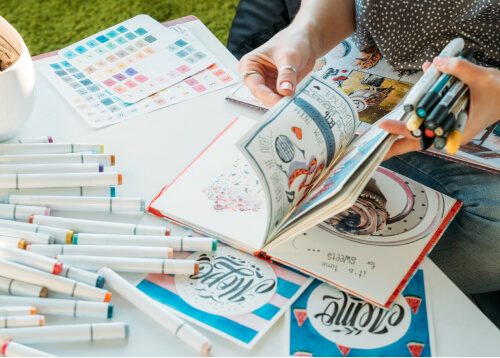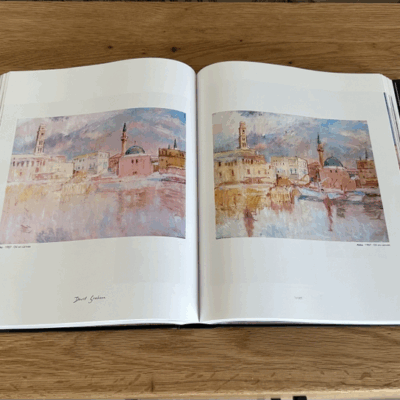How to Achieve Museum-Grade Results in Your art book Print
Introducing the Keys of Effective Art Book Printing Techniques for Creative Professionals
When it comes to creating an art book, every detail matters. You require to think about paper option, binding choices, and shade precision. What are the vital strategies that can assure your art book stands out in a jampacked market?
Comprehending the Value of Paper Choice
When it comes to art book printing, paper option is important for achieving the desired aesthetic effect. The kind of paper you select can substantially influence just how shades show up, structures feel, and how your artwork resonates with viewers.
A glossy coating can make colors pop, while a matte surface area may offer a more subdued, creative vibe. In addition, do not neglect the importance of acid-free paper to assure durability and stop yellowing in time.
Test samples before settling your choice; this'll help you see exactly how your art communicates with different documents. Eventually, the ideal paper can elevate your art book from ordinary to phenomenal, making a long-term impact on your audience.
Checking Out Binding Choices for Art Books
As you submerse on your own in the world of art book printing, checking out binding alternatives is essential for bringing your vision to life. The option of binding influences not just the visual appeals but likewise the capability of your book.
For a robust and creative feel, instance binding supplies sturdiness and a professional touch. If your book consists of special elements, like fold-outs or combined media, lay-flat binding may be your best option, allowing web pages to open up fully without losing material. Each choice has its strengths, so consider your book's function and target market. Select wisely, and your binding will certainly improve the overall influence of your art book.
Mastering Shade Precision in Print

When preparing your documents, transform images to the CMYK color setting, as this is what printers utilize. Be mindful of shade rooms; Adobe RGB provides a broader range than sRGB, however it's crucial to transform to CMYK prior to printing to prevent shocks.
Test prints are vital; they let you see exactly how shades translate to paper. Make changes based upon these evidence. Interact with your printer concerning your shade expectations-- collaboration can lead to sensational results. With interest to information, you can achieve lively, true-to-life shades in your art book.
Ensuring High Photo Resolution for High Quality
To ensure your art book captures the spectacular detail of your images, high photo resolution is necessary. Goal for a minimum of 300 DPI (dots per inch) for perfect high quality. This guarantees that every information in your artwork appears crisp and lively, allowing your viewers to appreciate the nuances of your imagination.
When preparing your pictures, always begin with the highest possible resolution possible. If you're checking artwork, utilize a top quality scanner and pick the proper setups. If you're making use of electronic documents, ensure they're saved in layouts like TIFF or PNG, which preserve photo top quality better than JPEGs.
Likewise, think about the final size of your pictures in print. A picture that looks excellent on your display may not translate well to print if it's as well tiny. By concentrating on high image resolution, you'll produce a professional art book that showcases your operate in the ideal light.
The Role of Format and Layout in Art Books
While crafting an art book, the layout and design play a vital function in enhancing the visual experience. You want your target market to involve with your work, and a thoughtful design can more info assist their journey through the pages. Take into consideration the equilibrium in between message and pictures; way too much text can bewilder, while insufficient may leave your message vague.
Usage whitespace successfully to give your artwork breathing space, allowing each piece to radiate. Assume about the circulation of the web pages-- how each photo engages with the next. This can create a story that draws readers in and maintains them astounded.
Don't neglect typography! Picking the ideal typefaces can complement your art work and reinforce your style. Make sure your style straightens with the total motif of your book, developing a cohesive experience. With mindful focus to design and design, your art book can website end up being a magnificent aesthetic story that reverberates with your audience.
Choosing the Right Printing Strategy
The right printing method can considerably affect exactly how your art book is viewed and experienced. Digital printing is perfect for short runs, providing fast turnaround times and vibrant shades that bring your artwork to life.

Budgeting for Art Book Production
Budgeting for art book production is vital, and getting a clear photo of your expenses can conserve you from unforeseen costs later. Start by defining your budget plan, considering all facets like style, printing, and distribution. Research printing options to discover one that fits your top quality and amount demands without breaking the bank.
Don't forget to consist of expenses for materials, such as paper and ink, as well as any type of additional features like embossing or specialized finishes. Factor in style costs, whether you're doing it yourself or working with an expert. Also, represent advertising and marketing and promo, as they're necessary for reaching your audience.

Regularly Asked Inquiries
What Are the Ideal Printers for Art Book Projects?
When choosing printers for your art book tasks, think check here about premium inkjet versions like Canon or Epson. They provide vivid colors and sharp information, guaranteeing your artwork stands out perfectly on every web page.
Exactly how Do I Prepare My Declare Printing?
To prepare your documents for printing, guarantee you've set the appropriate resolution, color mode, and file format (art book). Don't forget to consist of hemorrhage and chop marks, so your artwork publishes flawlessly with no undesirable borders
What Is the Typical Turnaround Time for Art Book Printing?
The average turnaround time for art book printing varies, yet you can normally expect it to take between 2 to four weeks. Aspects like complexity and quantity can impact this timeline, so strategy appropriately.
Can I Publish Art Books in Little Amounts?
Yes, you can publish art books in small amounts. Numerous printing services offer short-run alternatives, allowing you to produce minimal versions without high upfront expenses. This flexibility helps display your work while managing budget plan constraints effectively.
What Are Usual Blunders to Prevent in Art Book Printing?
When publishing art books, stay clear of common errors like poor documents resolution, overlooking color calibration, and overlooking to check. Also, don't take too lightly the importance of picking the right paper and binding strategies for your job.